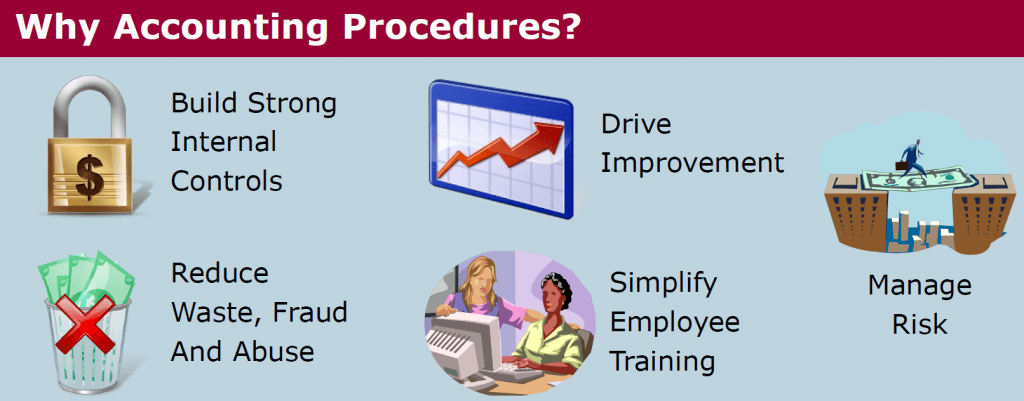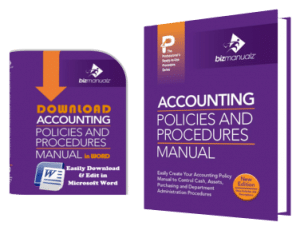Do Your Accounting Procedures Drive Internal Control?

How can you make the most of your accounting manual and accounting policies and procedures to support your internal control objectives? But do your accounting procedures drive internal control already?
Accounting Procedures are Key to Driving Internal Control
We know from COSO and Sarbanes Oxley compliance that accounting procedures are an important element of your internal controls. Organizations spend a lot of effort to produce an accounting manual containing accounting policies and procedures.
There are two important questions you should ask about your accounting procedures:
1) How well do your accounting procedures accurately capture your accounting cycles or processes?
2) How can your use your accounting procedures to benefit your organization?
To get started, try our free sample internal control procedures
A Positive Contribution from Accounting Procedures
Accounting procedures are an important way to communicate management’s philosophy or vision for running the organization. It is within this framework that employees use accounting policies to guide decision making as well as establish effectiveness criteria, key performance indicators, or metrics that help determine the organization’s level of success.
Accounting Methods of Internal Control
Implementing accounting policies and procedures is one method of creating the internal controls needed for a successful and compliant (i.e. SOX) organization. Accounting policies that don’t communicate management’s vision for operations, but simply state hard and fast accounting rules without explanation are less useful in communicating with employees.
Your accounting procedures probably describes an accounting process as a collection of process steps and associated rules.
For example; a accounts receivable collection process might send out collection notices, make phone calls, collect money, deposit money; and then repeat.
Accounting Data
Where in this accounting process do you collect data that measures how effective the accounting process is? When are you comparing results to objectives? In a more broad view, control is more that just a set of steps and/or a list of rules. Control is awareness of how well your accounting processes are carrying out important functions. On this path the accounting processes your accounting procedures describe can really provide an important contribution to your business.
The legal, regulatory and ethical concerns surrounding accounting processes only emphasize the importance of having good accounting procedure documentation. But the difference between a controlled accounting process with measurement and review and an uncontrolled accounting collection process can be described with one word: success.
A Different Version of an Accounting Control Procedure
Controlled processes collect data as in integral part of the business process steps. Now, at regular intervals, the data can be reviewed and accounting process effectiveness evaluated. Are objectives being reached?
If not, why? Are the objectives meaningful and reflect importance and risk? Now, the necessary corrections can be identified and implemented as a result of the review.
For example; a controlled accounting collection process might send out two different collection notices to test the response rate of different notices, you may also make phone calls at defined intervals to determine the response rate. Collecting data means making reflective and meaningful adjustments to the business process.
Typically, auditors accept accounting procedures that list steps and rules, with lots of inspection and verification steps, as an adequate internal control system. What value, however, does that internal control system provide for your organization? As a business owner, CFO, Controller, or accounting department manager, is an internal control system that does the bare minimum good enough?
Using Process Design to Develop Standard Accounting Procedures
Understanding the accounting processes is the first step in being able to document them with well-written accounting procedures. Besides noting the steps of the accounting process, consider the following:
- Who is the accounting process owner?
- How do accounting processes interact? What are the inputs, outputs, customers, suppliers?
- What are the most important facets for process and organizational success?
- What are the risks associated with the accounting procedures (what could go wrong and how material would it be?)
Accounting Processes
You might find process maps, flowcharts, or similar tools useful during this phase. Be sure to identify accounting process objectives, key metrics and how they are recorded, as well as how frequently they should be reviewed.
Once you start reflectively analyzing your process, you may notice better approaches or waste that can be eliminated. You might, however, want to avoid introducing too much change too quickly.
Accounting Strategy
One accounting control strategy is to introduce the most important changes first (according to risk, return, etc…) then introduce more process improvements over time through other improvement activities. Once you understand your process and incorporate process improvements, data collection, and review, you are ready to start writing your accounting procedures.
Accounting Procedures
After planning and analyzing an accounting process, writing an accounting procedure to document it should seem easy. One tip is to focus on describing the accounting process and avoid too much mundane detail (i.e. computer instructions). Too much detail makes the accounting procedure unfriendly to users, and those details are only needed by beginners anyway. Keep that information in training materials or work instructions.
Remember, simplicity and consistency (even with other organizational procedures) is a positive attribute of an accounting procedure. It is easier to add necessary information later as needed than it is to identify and strip out useless information and needless detail.
Accounting Procedures to Benefit Your Organization
Everywhere in your organization people are carrying out business processes to make things happen. This obviously includes the accounting department.
Viewing accounting procedures as a way to communicate information about the overall mission or strategy of a particular function or accounting process does aid and inform organizational members. When these overarching goals of the accounting process are translated into specific metrics or effectiveness criteria, now the puzzle is complete.
Your accounting policies should provide the guidance that helps establish criteria, but the accounting policy itself should not be the criteria. In terms of an accounting manual for internal control, which method provides better internal controls: a set of accounting rules that may or may not be followed; or expressed guidance that fulfills organizational goals and leads to establishing criteria, which in turn clearly demonstrates how effective accounting processes are carrying out accounting policies?
Accounting Procedures Drive Internal Control
Rules may be followed, and one could claim that they provide control. But expressed rules will never play a role in improving the organization, and improvement should always be an organizational goal of any accounting manager or organizational leader.
Thinking of accounting policies as an expression of mission or strategy is a positive step in establishing clear communication with your staff and starting down the path of continual improvement. The accounting policy clearly communicates goals, and the accounting procedure communicates the accounting process in order to execute it and reach the goals.
The periodic review of accounting process objectives provides feedback for the accounting policy ensuring it is still current in reflecting what is important to your organization. Check out the Accounting Policies and Procedures Manual or download free sample accounting procedures right now.

















Leave a Reply